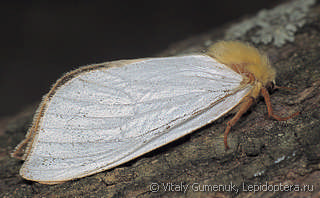Hepialus humuli
Taxonomy
class Insecta
Species name(s)
Hepialus humuli (Linnaeus, 1758) = Phalaena (Noctua) humuli Linnaeus, 1758 = Hepialus thulensis Newman, 1865 = hethlandica Staudinger, 1871 = rosea Petersen, 1902 = grandis Pfitzner, 1912 = dannenbergi Stephan, 1923 = pusillus Stephan, 1923 = faeroensis Dahl, 1954 = fumosa Cockayne, 1955 = radiata Cockayne, 1955 = griseomaculata van Wisselingh, 1965. [9, 10]
Ghost Moth.
urn:lsid:insecta.pro:taxonomy:6250
Expansion
This species marks on the maps: 1.
Zoogeographical regions
Palaearctic.
Russia regions
#1. Kaliningradsky; #4. Evropeisky Severo-Zapadny; #6. Evropeisky Severo-Vostochny; #7. Evropeisky yuzhno-tayozhny; #8. Evropeisky Tsentralny; #9. Evropeisky Tsentralno-Chernozyomny; #10. Sredne-Volzhsky; #11. Volgo-Donsky; #13. Zapadno-Kavkazsky; #14. Vostochno-Kavkazsky; #15. Severo-Uralsky; #16. Sredne-Uralsky; #17. Yuzhno-Uralsky; #19. Sredneobsky; #20. Yuzhno-Zapadnosibirsky; #21. Severo-Yeniseisky; #22. Krasnoyarsky; #23. Predaltaisky; #27. Pribaikalsky; #36. Sredne-Amursky*; #37. Nizhne-Amursky*.
* An asterisk denotes a region for which the species is listed as an migrant or information that requires additional checking.
Forewing length
20—35 mm.
Primary colors
Orange, Yellow, White.
Flight time
| January | February | March | April | May | June | July | August | September | October | November | December |
Larva lifespan
| January | February | March | April | May | June | July | August | September | October | November | December |
Over-wintering stage
Larva.
Detailed information with references
Distribution
Imago Habitus and Differences from alike species
General info about Imago
Imago lifespan
General info about Larva
Larva food plants / other food objects
Larva lifespan
Egg
Overwintering stage
Subspecies of Hepialus humuli
- Hepialus humuli azuga Pfitzner,1912. [187]
- H. h. faeroensis Dahl,1954. [187]
- H. h. grandis Pfitzner,1912. [187]
- H. h. griseomaculata Van Wisselingh,1965. [187]
- H. h. humuli (Linnaeus, 1758). [10]
- H. h. postnigrescens Lempke,1961. [187]
- H. h. postrufescens Lempke, 1961. [187]
- H. h. thulensis (Newman, 1865). [10]
Authors
Initial species uploading to the site: Peter Khramov.
Text data: Peter Khramov.
The species characteristics formalization: Peter Khramov, Sergei Kotov.
References
- [1] O. Karsholt, J. Razowski (eds.), 1996. The Lepidoptera of Europe: a distributional checklist
- [3] Каталог чешуекрылых (Lepidoptera) России. Под ред. С. Ю. Синёва. СПб.; М.: Товарищество научных изданий КМК, 2008
- [5] Райххолф-Рим Х. Бабочки. М.: Астрель, 2002
- [9] Tree of Life (funet.fi), 2012
- [10] de Jong, Y.S.D.M. (ed.) (2011) Fauna Europaea version 2.4 (faunaeur.org)
- [11] Жизнь животных по А. Э. Брему. Т.2: Членистоногие. М.: Учпедгиз РСФСР, 1941
- [187] Species 2000, http://www.sp2000.org
Comments
Note: you should have a Insecta.pro account to upload new topics and comments. Please, create an account or log in to add comments
Hepialus humuli photos


















All the photos of the species in large size
Please, create an account or log in to upload your photo


